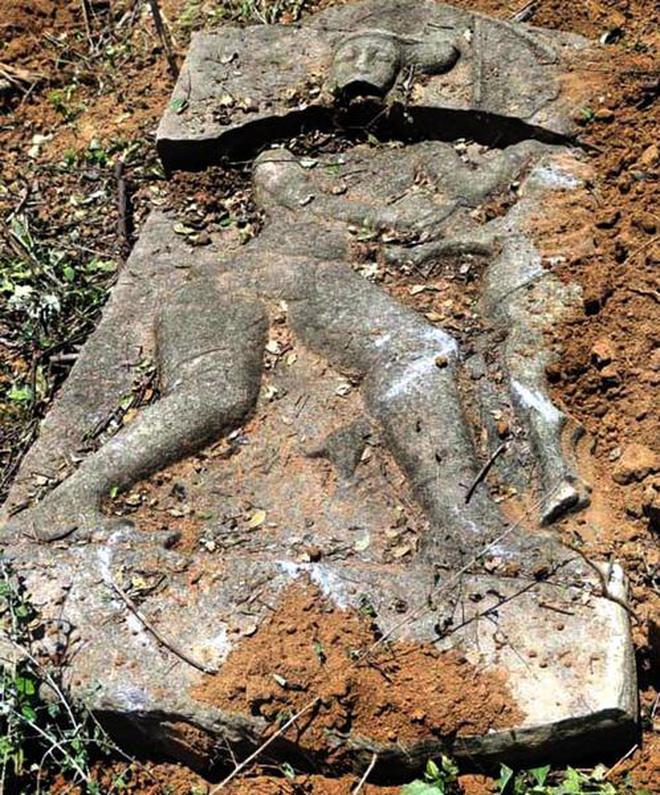The numerous monuments and heritage sites in the Rayalaseema region, comprising the southern districts of Andhra Pradesh, stand as tall reminders of the region’s historical significance. The culture in the region also greatly reflects the mark that the many dynasties that once ruled the land made on its people.
However, the burial sites from the megalithic era spread across the region reveal that the land’s history is much richer than many know. The region also finds its references in Hindu mythology.
Tirupati district is dotted with anthropomorphic burial sites, which indicate the existence of human civilisation at the place during the megalithic era. These burial sites are said to be the largest collection in the State. However, most are in a state of neglect, with neither the government nor the locals showing interest in protecting the vital clues about our antecedents, which deserve to be preserved as relics of cherished heritage.
The most prominent relic is the ‘pillared dolmen’ of the megalithic era, found at the little-known Mallayyagaripalle village, 20 km west of Tirupati. The structure, locally referred to as ‘Pandava Gullu’ or ‘Pandavula Banda’ in memory of the Pandavas, is estimated to be 2,500 years old.

Compared to other districts, the erstwhile combined Chittoor district has an array of such structures. “This could be an indication of the presence of humans living in groups during the megalithic period (500–300 BC) in this region,” observes noted archaeologist Sivakumar Challa, who is associated with the Archaeology Research Group (ARG).
Rampant granite mining around the Chandragiri area wreaked havoc on the pillared dolmen with rock art beneath the capstone at Mallayyagaripalle. The site was almost razed down, but the timely alarm the local villagers and anthropologists raised stopped the mining activity.
The Mallayyagaripalle structure is a cist burial chamber. Such chambers are built by arranging slabs neatly broken from huge stones at a time when there were no proper tools. There is another endangered megalith monument in Palem village near Kallur, which resembles a bull’s horn. Called locally as ‘Devara Yeddhu’, the site has suffered repeated damage due to clandestine excavation by treasure hunters. Also, an electric post was fixed very close to the site, in a classic act of official apathy.
Yet another type of megalithic burial site is the ‘stone circle’, where the tomb is surrounded by round stones arranged in a circle. One such site in Venkatapuram, 15 km east of Tirupati near Karakambadi, is damaged due to the installation of a mobile tower.
Late V. Ramabrahmam, an assistant professor of history and archaeology at Yogi Vemana University, Kadapa, who had done extensive research on dolmens, had stated in one of his works about the megalithic people’s staunch belief in life after death and the travel embarked by soul to other worlds.
Confirming the belief, Mr. Sivakumar said the megalithic people used to keep food and tools inside the chamber for use by the dead person. A ‘menhir’—a tall or grand structure erected in memory of a dead person—found at Boyapalle near Sodam is also damaged. ‘Slab circles’, an arrangement of three or seven slabs in a circular fashion, found in Eguva Gunthalacheruvu of Annamayya district, are also in a state of neglect.
Dilapidated well
A dilapidated well dating back to the Sadasiva Devaraya era of Vijayanagara empire was recently unearthed in Mydukur constituency of Kadapa district, abutting the Nallamala forest.
The well ‘Veerla Baaduva Bavi’ is located on the lower side of Yerra Cheruvu tank near Thippireddygaripalle village. The well is located west of where a little creek joins the stream passing through the forest. It is believed to belong to 16th century when the empire was under the control of Sadasiva Devaraya.
Braving the thorny shrubs and the presence of wild animals in this tiger reserve, a team of four villagers crawled to the remote location that was apparently a throbbing village once.
“We found an inscription pertaining to land endowment in this very location that dates to Sadasiva Devaraya’s period. Taking a cue, we can hence correlate that the well could have served the needs of the village that had once existed”, says K. Muniratnam Reddy, Director (Epigraphy) at Archaeological Survey of India (ASI).
Hero stones
In the recent past, the same Mydukur mandal also witnessed the unearthing of a damaged ‘Hero stone’ belonging to the ninth century.
The stone was identified near Puttakanuma by writer Bommisetty Ramesh, which faces east and buried in the midst of earthen walls, pointing to the possibility of existence of a human habitation.
Hero stones, called as ‘Veeragallu’ in Telugu, are normally the sculpted rock pieces chiseled in memory of warriors to commemorate their martyrdom. As Kadapa district is known for valour and righteousness, there are several such memorials raised for the various social causes the heroes had fought for.
This particular stone shows a man fighting a tiger (which are in sizeable numbers even today in this Nallamala belt) in a bid to save the herd of cows belonging to his village.
Senior historian Avadhanam Umamaheswara Sastry has mentioned the presence of such hero stones in his doctoral research work ‘Kadapa Jilla Sasanalu – Samskruti Charitra’, pursued at Sri Krishnadevaraya University. He even referred to a ninth-century inscription found near Rayavaram, which mentioned the death of a warrior, ‘Kokila Adiyamma’, while resisting the seizure of cows by rivals. Cow abduction was an act of vengeance in those days, which even led to battles between communities or villages.
The region remains largely unexplored and forms a rich source of evidence for researchers awaiting to be unearthed.







